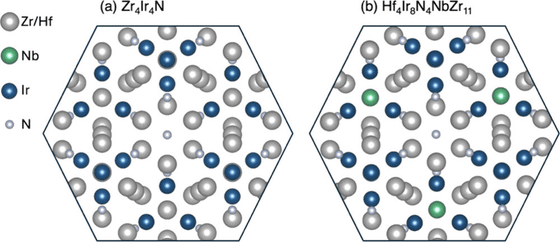Researchers refute Google DeepMind's claim that it used AI to discover 2.2 million new crystal structures

Google's AI research division, Google DeepMind, announced that it had discovered 2.2 million 'new crystal structures that are theoretically stable but have not been experimentally realized' using an AI tool called 'GNoME'. However, after analyzing the new crystal structures announced by Google DeepMind, several researchers have
Artificial Intelligence Driving Materials Discovery? Perspective on the Article: Scaling Deep Learning for Materials Discovery | Chemistry of Materials
https://pubs.acs.org/doi/10.1021/acs.chemmater.4c00643
PRX Energy 3, 011002 (2024) - Challenges in High-Throughput Inorganic Materials Prediction and Autonomous Synthesis
https://journals.aps.org/prxenergy/abstract/10.1103/PRXEnergy.3.011002?ref=404media.co
Is Google's AI Actually Discovering 'Millions of New Materials?'
https://www.404media.co/google-says-it-discovered-millions-of-new-materials-with-ai-human-researchers/

Stable crystal structures are strongly related to various modern technologies, but obtaining stable crystals that are difficult to decompose requires precise experiments over several months. However, the Google DeepMind research team claimed in a paper published in Nature that they discovered 2.2 million new crystal structures through AI analysis by using Graph Networks for Materials Exploration (GNoME), a deep learning tool that dramatically improves the speed and efficiency of discovering new materials by predicting the stability of new materials. The 2.2 million types are more than 45 times the crystal structures discovered so far, and 380,000 of these are expected to be structurally stable, so Google DeepMind said, 'This discovery is equivalent to 800 years of knowledge.'
Google DeepMind uses AI tools to discover 2.2 million new crystal structures, more than 45 times the number previously discovered - GIGAZINE

Another paper published at the same time by researchers from Lawrence Berkeley National Laboratory supported Google DeepMind's announcement, stating, 'In collaboration with Google DeepMind, we have demonstrated how our AI predictions can be used for autonomous materials synthesis.' According to the researchers, they used an 'autonomous laboratory' that conducted analytical research without humans using computation, historical data from the literature, machine learning, and active learning, claiming that they 'demonstrated the effectiveness of an artificial intelligence-driven platform for autonomous materials discovery.'
However, in a paper published in April 2024 in the peer-reviewed scientific journal Chemistry of Materials, Anthony Cheatham and Ram Seshadri of the University of California, Santa Barbara analyzed the papers from Google DeepMind and Berkeley National Laboratory and argued that, 'While AI certainly holds great promise for discovering new types of materials, the research result of finding 2.2 million new crystal structures is an overestimate.'
In the study, several hundred samples were randomly selected from the 380,000 'stable new crystal structures' published by Google DeepMind, and three-stage tests were conducted to determine whether the crystals were 'reliable,' 'useful,' and 'novel.' What Google DeepMind discovered was not limited to general 'materials' and was not limited to those that demonstrated some usefulness, so it is not necessarily useful. However, even after analyzing it with that in mind, Cheatham and Seshadri said that none of the randomly selected samples met sufficient criteria. Below is an example shown in the paper, with the known crystal structure on the left and the new structure proposed by Google DeepMind on the right. The new structure has almost the same structure except for the inclusion of 'Nb (niobium),' and according to the paper, 'in this case, it is unlikely that the proposed crystal structure is considered novel.'

The paper points out that 'the list of 384,870 stable crystal structures did not contain any compounds with surprising novelty. Many of the new crystal structures are simply modifications of known materials.' In an interview with technology media 404media, Cheesam said, 'Google's paper is quite inadequate in terms of useful and practical contributions to material scientists. Whether a new crystal structure can perform a specific function requires focusing on a specific need and thoroughly exploring the possibilities to determine whether it is useful. However, it is difficult to consider 2.2 million new crystal structures. This time, we randomly considered some of them, and even if they were stable, they were neither novel nor useful. '
Leslie Shupe of Princeton University and Robert Palgrave of University College London analyzed the Berkeley National Laboratory's autonomous laboratory presentation and noted that 'no new materials were discovered in the study.' While Shupe and Palgrave acknowledged, like Cheatham and others, that the AI-driven process of discovering new materials is promising, they said, 'At least in its current form, the presentation does not include any major advances and should not be presented in that context.'
'The Google DeepMind paper contains a lot of obviously nonsense predictions that even most high school students would understand, not just experts in the field,' Palgrave said. 'To me it looks like there's no basic quality control going on. The fact that the AI is outputting such compounds as predictions is alarming and indicates something is wrong.'
In response to the rebuttal paper, Google DeepMind said in a statement, 'We stand by all of the assertions made in Google DeepMind's GNoME paper.'
Related Posts:






